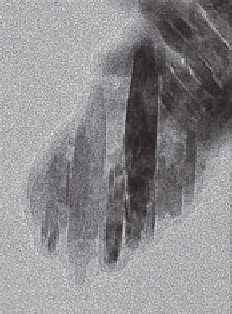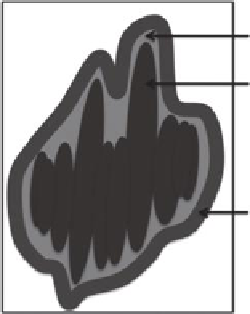Biomedical Engineering Reference
In-Depth Information
types of particles were detected in the aerosol. A spray containing nano-ZnO for
example contained agglomerated ZnO surrounded by an acrylate polymer matrix.
Quadros and Marr (2011) also found that three commercially available sprays
containing Ag released the Ag mainly as particles larger than 0.5 µm in the aerosol.
Collection of the droplets and drying under vacuum revealed spherical particles that
were mostly below 100 nm in size.
15.3.6 s
unsCreens
Among the wide variety of nanomaterials that are used in consumer products, the
UV absorbing nanoparticles used in sunscreens are the ENM category with the high-
est priority for further elucidating their exposure and effects (Wijnhoven et al. 2009;
Dhanirama et al. 2011). Sunscreens are used up during use and thus almost complete
release into the environment can be expected. For a further understanding of the fate
and effects of these released materials it is therefore important to study the fate and
behavior of the materials released into water. The fate of a specific hydrophobic nano-
composite used in sunscreens after release into water has been studied extensively by
French researchers (Auffan et al. 2010; Labille et al. 2010; Botta et al. 2011). Figure 15.9
shows the nanocomposite consisting of a rutile (photocatalytic TiO
2
) core, an aluminum
oxide shell, and a PDMS coating (polydimethylsiloxane).
When this hydrophobic material comes into contact with water, it becomes hydro-
philic and forms aggregates (Auffan et al. 2010). The organic Si layer is desorbed to
more than 90% and the PDMS is degraded. The aluminum oxide layer is only affected
to a very small extent. A stable suspension of particles with sizes from 50 to 700 nm was
formed (Labille et al. 2010). About one fourth of the total mass of the added material
was found in this stable suspension after 48 h of exposure and 48 h of sedimentation,
Al(OH)
3
TiO
3
rutile
PDMS
20 nm
(a)
(b)
FIGURE 15.9
Transmission electron microscopy image of TiO
2
-AlOOH nanocomposite
used in sunscreen (a) and schematic view of the nanocomposite formulation (b), including the
PDMS layer. (Reprinted from
Environ. Pollut
., Labille, J. et al., Aging of TiO
2
nanocompos-
ites used in sunscreen. Dispersion and fate of the degradation products in aqueous environ-
ment, 3482-3489, Copyright 2010, with permission from Elsevier.)


Search WWH ::

Custom Search